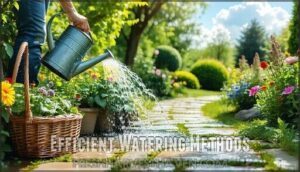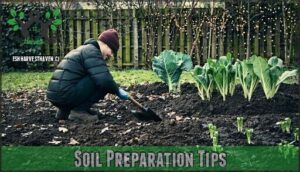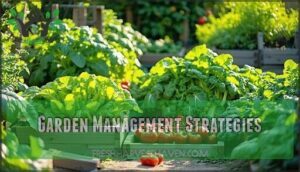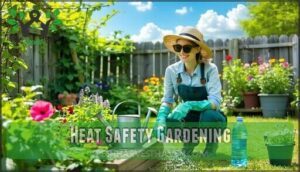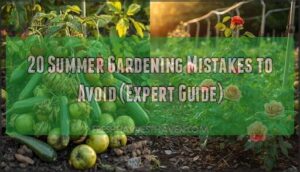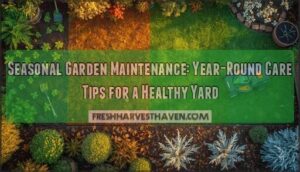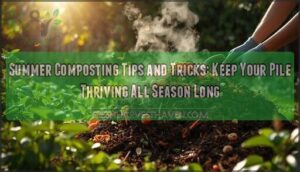This site is supported by our readers. We may earn a commission, at no cost to you, if you purchase through links.
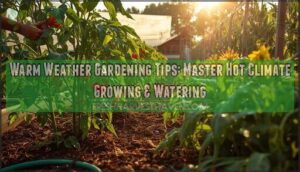
Smart warm weather gardening tips start with timing—water early morning when temperatures are cool and evaporation is minimal.
Choose heat-loving plants like tomatoes, peppers, and okra that actually thrive in scorching conditions.
Mulch becomes your best friend, keeping soil moisture locked in and roots protected from blazing sun.
Deep, less frequent watering beats daily sprinkles every time.
Create shade with row covers or strategically placed taller plants.
Don’t forget about yourself—garden during cooler hours to avoid heat exhaustion.
With the right approach, your summer garden can flourish despite the furnace-like conditions, producing abundant harvests when others struggle, and that’s the key to a successful summer garden.
Table Of Contents
- Key Takeaways
- Warm Weather Gardening
- Efficient Watering Methods
- Soil Preparation Tips
- Garden Management Strategies
- Heat Safety Gardening
- Frequently Asked Questions (FAQs)
- How to grow plants in 100 degree weather?
- What is the 3-hour gardening rule?
- What is the most common mistake of first time gardeners?
- How do I keep my garden looking good through heat waves?
- How do you protect a vegetable garden from heat?
- How do I cope with the heat in my garden?
- What can you grow in a hot weather garden?
- How hot is too hot for a vegetable garden?
- How can I Help my plants survive hot and dry spells?
- How to garden when it’s hot?
- Conclusion
Key Takeaways
- Time your watering right – Water between 5-9 AM when temperatures are cool and evaporation is minimal; then water deeply but less frequently to encourage strong root development.
- Choose heat-loving plants – Select varieties like tomatoes, peppers, okra, and drought-resistant options that actually thrive in scorching conditions rather than struggle against the heat.
- Use mulch as your secret weapon – Apply a 2-3 inch layer of organic mulch around plants to lock in soil moisture, regulate temperature, and protect roots from the blazing sun.
- Create shade and garden smart – Install shade cloth or row covers during extreme heat, and schedule your gardening activities during cooler morning hours to protect both plants and yourself.
Warm Weather Gardening
You can grow amazing plants even when summer heat reaches extreme levels. Choose the right varieties and use smart watering techniques to keep your garden thriving through the hottest months.
Heat Tolerant Plants
When gardening in warm weather, selecting heat tolerant plants sets you up for success.
These hardy varieties thrive when temperatures soar, making your garden flourish despite challenging conditions.
- Succulent Varieties – Aloe, agave, and echeveria store water efficiently
- Drought Resistance – Lavender and rosemary handle dry spells naturally
- Native Options – Regional plants adapt perfectly to local climate conditions
- Sun Requirements – Choose full-sun plants that welcome intense heat exposure
Desert Vegetables
You can grow amazing crops even in scorching desert conditions. Okra, Armenian cucumber, and tepary beans show remarkable drought resistance. These native varieties need minimal irrigation needs compared to standard vegetables.
Desert-adapted crops thrive with minimal water while delivering maximum flavor and nutrition.
Eggplant and Malabar spinach handle extreme heat while black-eyed peas thrive with little water. Focus on soil amendments like compost for better moisture retention.
Pest control becomes simpler with hardy desert-adapted plants that naturally resist common garden problems. Many gardeners find success with edible perennial varieties that require less replanting, which is a key factor for desert garden success and minimal irrigation needs, making it easier to maintain a thriving garden with less replanting.
Southern State Crops
Southern states offer prime growing conditions for cash crops that thrive in extended heat.
Your warm climate garden can mirror commercial successes with these powerhouse performers.
- Cotton Production – Requires 200+ frost-free days for fiber development
- Pecan Cultivation – Georgia leads with 180,000+ acres of heat-loving trees
- Citrus Varieties – Florida’s 380,000 acres prove oranges love consistent warmth
- Peach Farming – South Carolina ranks second nationally in peach acreage
- Tobacco Industry – Virginia and North Carolina harvest July through August
Consider using raised beds for optimal growing conditions to maximize yields.
Tropical Fruits
You’ll find exotic varieties like mangoes and papayas thrive in warm weather gardening conditions above 60°F with high humidity.
These warm climate plants need full sun and well-draining soil for ideal fruit ripening.
Watch for pest control issues and enjoy their exceptional nutritional benefits when properly grown.
Efficient Watering Methods
When hot weather hits your garden, smart watering becomes your plants’ lifeline.
You’ll save water and keep your crops thriving by timing your irrigation right and choosing methods that get moisture directly to the roots.
Deep Watering Techniques
Deep watering techniques transform your warm weather gardening success by encouraging strong root development below surface level.
Water slowly and thoroughly to reach deeper soil layers where moisture stays longer during hot days.
To further improve water efficiency, consider organic mulch options for your garden.
- Soak soil 6-8 inches deep rather than frequent shallow sprinkles
- Apply water at soil base to minimize evaporation losses
- Use soaker hoses for steady water retention in different soil types
- Adjust watering frequency based on plant health and weather conditions to ensure optimal water efficiency.
Soil Moisture Checks
Checking soil moisture prevents both overwatering and underwatering.
Use Visual Inspection to spot dry surface cracks or dark wet patches. The Soil Feel method works best – stick your finger two inches deep.
Moisture Meters provide accurate readings for Root Health monitoring. Watch for Wilting Signs as early drought indicators.
| Method | Depth Check |
|---|---|
| Visual Inspection | Surface only |
| Soil Feel | 2-3 inches |
| Moisture Meters | Variable |
Drip Irrigation Methods
Smart drip irrigation systems deliver water directly to plant roots with incredible precision.
Choose emitter types based on your plants’ needs – micro bubblers for large areas or point drippers for individual plants.
Proper water pressure guarantees consistent flow rates, and consider different drip irrigation products for system customization.
Regular maintenance keeps systems running smoothly, and automation options with timers make drought resistant gardening effortless during hot weather conditions.
Morning Watering
Morning watering gives your plants the best start to beat summer heat.
Water between 5-9 AM for maximum benefits including evaporation reduction and disease prevention.
- Evaporation Reduction – Cool morning air means less water loss
- Disease Prevention – Foliage dries quickly preventing fungal problems
- Deeper Infiltration – Soil absorbs water before heat creates surface barriers
- Consistent Timing – Regular schedule builds plant resilience against stress
- Energy Efficiency – Plants use water immediately for daily growth needs
Avoiding Overwatering
Overwatering plants in hot weather creates more problems than drought stress.
Check soil drainage before watering by inserting your finger two inches deep into the soil. Good drainage prevents root rot while proper watering frequency depends on plant needs and container selection.
Focus on deep watering less often rather than frequent shallow watering for healthier summer gardens, which is a key factor in preventing root rot.
Soil Preparation Tips
Your soil needs the right foundation to handle intense heat and keep plants thriving through scorching summer days.
Focus on building rich organic matter and creating conditions that help roots stay cool and hydrated when temperatures soar, which is crucial for the soil to have the right foundation.
Organic Matter Levels
Your soil needs the right amount of organic matter to thrive in hot weather. Aim for 3-5% organic content to boost water retention and carbon sequestration. Quality soil amendments create the foundation for successful warm weather gardening advice.
Here’s how to optimize organic matter levels:
- Add 2-3 inches of compost annually for steady humus formation and compost benefits
- Mix in aged manure to increase soil structure and nutrient availability
- Layer organic mulch around plants to decompose slowly into the soil
- Test soil levels yearly to track your soil preparation summer progress
Beneficial Soil Organisms
Your garden’s underground workforce includes earthworms that consume 20-40 tons of soil yearly while creating tunnels for better drainage.
Mycorrhizal networks connect plant roots to boost nutrient uptake and heat resistance. Nitrogen fixation bacteria supply essential nutrients naturally.
These beneficial organisms form a thriving soil foodweb that supports decomposition processes. Adding organic amendments feeds this ecosystem for successful warm weather gardening.
Conservation tillage helps prevent soil compaction issues to ensure a healthy underground environment.
Ideal Soil Conditions
Your foundation determines success.
Target soil pH between 6.0-7.0 for ideal nutrient absorption in warm weather gardening.
Well-draining soil prevents root rot during humid conditions.
Loamy texture balances water retention and drainage needs.
Test soil composition regularly.
Sandy soils drain quickly but need frequent watering in hot weather.
Clay holds moisture but requires amendments for proper drainage in dry conditions, and well-draining soil is crucial, with loamy texture being ideal, and maintaining the right soil pH.
Mulch Application
Apply a 2-3 inch layer of organic mulch around your plants, keeping it several inches from stems.
Choose from wood chips, straw, or shredded leaves for effective mulching techniques. Consider different types available for your specific needs.
This simple step provides excellent weed control while boosting moisture retention and regulating soil temperature. Your summer garden tips just got easier with proper mulch application for superior summer plant care in hot weather.
Soil Erosion Prevention
Heavy rains can wash away precious topsoil faster than you’d think.
Terracing techniques and retaining walls help slow water flow on slopes. Plant cover crops between growing seasons to anchor soil with roots.
Windbreaks protect against erosive winds. Contour plowing follows land curves rather than straight lines.
These gardening techniques preserve your soil investment for successful drought resistant gardening, using methods like contour plowing.
Garden Management Strategies
Successful warm weather gardening requires smart management strategies that work with the heat instead of against it.
You’ll need to plan your garden layout, timing, and plant combinations to create a thriving ecosystem that can handle intense temperatures.
Path Material Selection
Once your soil is set, it’s time to pick the right path materials for warm weather gardening.
Permeable Pavers let water soak in, while Gravel Options and Stone Dust keep things cool underfoot.
Wood Chips add a natural look, and Stepping Stones help avoid muddy shoes.
Check a gardening advice forum for real tips on gardening in hot, sunny weather, and consider Permeable Pavers for your path.
Seed Starting Techniques
Start your seeds indoors six to eight weeks before transplanting to beat summer heat.
Check Soil Temperature reaches 65-75°F for ideal Germination Rates.
Use Indoor Lighting for 12-16 hours daily to strengthen seedlings.
Test Seed Viability by germinating a few samples first.
Begin Seedling Hardening two weeks before transplanting outdoors, gradually exposing them to sun and wind for successful vegetable gardening summer phases.
Fruit Harvesting Strategies
During peak summer heat, timing becomes your greatest ally for successful fruit harvesting in warm weather conditions.
Monitor ripeness indicators like color changes and gentle firmness to determine ideal timing for each crop.
- Early morning harvest – Collect fruits between 6-8 AM when temperatures stay cool and sugar content peaks
- Proper harvesting tools – Use clean pruning shears and collection baskets to prevent pest damage and bruising
- Quick storage methods – Move harvested produce to cool shade immediately to maintain freshness and extend shelf life
Crop Rotation Strategies
Rotate plant families every three to four years to break pest cycles and prevent nutrient depletion.
Group warm weather crops by family: nightshades, legumes, brassicas, and cucurbits.
Plan seasonal planting sequences that improve soil health naturally.
Map your garden beds and document rotation planning to track which families grew where, ensuring effective gardening strategies for long-term success.
Companion Planting Methods
Plant companions strategically to maximize your warm weather gardening success.
Basil near tomatoes provides natural pest control while attracting beneficial pollinators. Tall sunflowers offer growth support for climbing beans through space optimization.
Deep-rooted plants paired with shallow ones enhance nutrient cycling. Increased harvest yields are another benefit of companion planting.
These gardening strategies create thriving ecosystems where plant care becomes simpler and more effective during summer’s challenges.
Heat Safety Gardening
Protecting yourself from heat while gardening guarantees you can enjoy your plants without risking heat exhaustion or sunburn.
Smart timing and proper preparation let you garden safely even when temperatures soar above 85°F.
Temperature Tolerance
Understanding your Hardiness Zones helps you choose plants that thrive in local weather conditions.
Microclimates Impact your garden’s success – southern-facing walls create warmer pockets for heat-loving crops.
Most vegetables need Heat Acclimation when temperatures exceed 90°F.
Cold Tolerance varies by species, with some handling unexpected cool snaps better than others.
Warm climate gardening requires matching plants to your zone’s temperature extremes.
Soil Moisture Management
Checking soil moisture prevents both drought stress and root rot in hot weather gardening. Your plants need consistent hydration without waterlogged conditions.
- Check soil 2-3 inches deep – Stick your finger into the earth to test actual moisture levels
- Install moisture sensors – These tools give precise readings for timely water retention
- Apply mulch layers – Reduces evaporation and maintains steady soil saturation around roots
- Water deeply but less frequently – Encourages strong root hydration instead of shallow watering
- Monitor drainage patterns – Verify excess water escapes to prevent soggy conditions
Shade Provision Methods
Creating shade in hot weather gardening protects both plants and gardeners from harsh sun.
Install shade cloth over vulnerable crops using simple posts or existing structures. Design trellis systems that support climbing plants while casting cooling shadows below.
Portable shelters work well for container gardens you can move. Reflective surfaces like aluminum mulch redirect heat away from plant roots.
Natural canopies from taller plants provide organic sun protection. You can find gardening shade solutions online to help with hot weather gardening.
Common Gardening Mistakes
Many gardeners sabotage their warm weather success through preventable gardening mistakes.
Ignoring climate needs leads to plant failure. Over-fertilizing burns roots during hot spells. Poor drainage creates waterlogged soil that kills plants. Pest neglect allows infestations to spread rapidly. Wrong spacing restricts airflow and increases disease risk.
- Planting cool-season crops during peak summer heat
- Watering at midday when evaporation is highest
- Using heavy fertilizers that stress heat-sensitive plants
- Crowding plants together without considering mature size
- Skipping regular pest monitoring during active growing seasons
Successful Gardening Techniques
You’ll enjoy gardening success when you apply proven strategies that work with hot weather conditions. Smart gardening tips include choosing heat-resistant varieties and timing activities during cooler hours.
Summer garden maintenance becomes easier when you follow these gardening best practices consistently. To improve soil health, consider using organic matter for soil.
| Technique | Best Practice | Hot Weather Benefit |
|---|---|---|
| Pest Control | Use beneficial insects and neem oil | Reduces chemical stress on heat-stressed plants |
| Vertical Gardening | Install trellises and climbing supports | Maximizes space while providing natural shade |
| Container Selection | Choose light-colored pots with drainage | Prevents root overheating and water retention |
| Pruning Techniques | Trim during early morning hours | Minimizes plant shock during extreme temperatures |
| Seed Saving | Harvest seeds from strongest plants | Creates heat-adapted varieties for future seasons |
Frequently Asked Questions (FAQs)
How to grow plants in 100 degree weather?
Plants struggle when temperatures exceed 86°F, with water loss increasing dramatically. You’ll need deep morning watering, shade cloth, mulching, and choosing heat-tolerant varieties like succulents or native plants to succeed.
What is the 3-hour gardening rule?
The 3-hour gardening rule suggests avoiding outdoor garden work during the hottest part of the day, typically 10 a.m. to 3 p.m., to protect both plants and gardeners from heat stress.
What is the most common mistake of first time gardeners?
Overzealous overwatering overwhelms plants, drowning roots and depleting oxygen. You’re killing them with kindness. Most beginners water daily when plants need less frequent, deeper watering to develop strong root systems.
How do I keep my garden looking good through heat waves?
Water deeply but less frequently in early morning. Use mulch to retain moisture and shade roots. Focus on drought-tolerant plants and provide temporary shade during extreme heat.
How do you protect a vegetable garden from heat?
Use shade cloth or row covers to shield plants during peak heat.
Water deeply in early morning to help roots stay cool.
Mulch heavily around plants to retain moisture and regulate soil temperature, using shade cloth is also an option but in this context, mulch is key.
How do I cope with the heat in my garden?
Stay hydrated, wear light clothing, and garden during cooler morning hours. Create shade with umbrellas or cloth. Mulch soil to retain moisture and keep roots cool.
What can you grow in a hot weather garden?
You’ll thrive growing heat-loving plants like tomatoes, peppers, eggplant, okra, beans, squash, melons, herbs like basil and oregano, plus drought-tolerant flowers like marigolds and zinnias.
How hot is too hot for a vegetable garden?
Most vegetables struggle when temperatures exceed 95°F consistently.
Like trying to sprint in a sauna, plants shut down their growth processes to survive extreme heat.
You’ll need shade cloth, extra watering, or heat-tolerant varieties.
How can I Help my plants survive hot and dry spells?
Water deeply but less frequently to encourage strong root systems.
Mulch around plants to retain moisture and cool soil.
Provide shade cloth during extreme heat.
Water early morning to minimize evaporation and stress.
How to garden when it’s hot?
Plants absorb 90% less water during midday heat.
Water early morning between 5-9 a.m. when evaporation’s minimal and soil infiltration’s best.
Use mulch to retain moisture, provide shade with row covers, and choose heat-tolerant varieties for sustained growth during scorching temperatures.
Conclusion
When the going gets tough, the tough get gardening.
These warm weather gardening tips will transform your blazing backyard into a productive paradise. Remember that timing beats everything else.
Water early, choose heat-loving plants, and mulch heavily. Deep watering trumps frequent sprinkles every time.
Create shade where you can and garden during cooler hours. Your summer garden doesn’t just survive the heat—it thrives in it.


